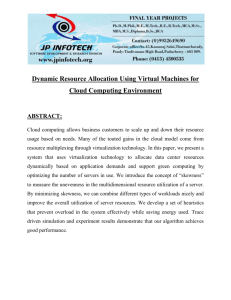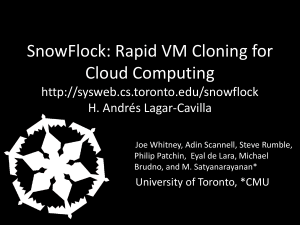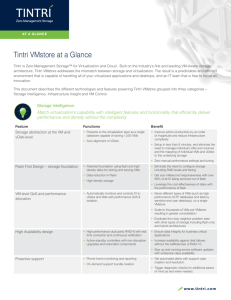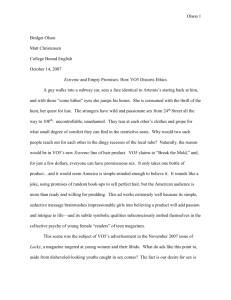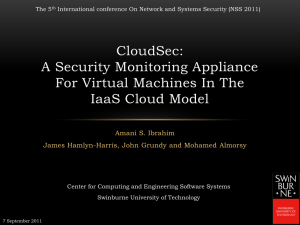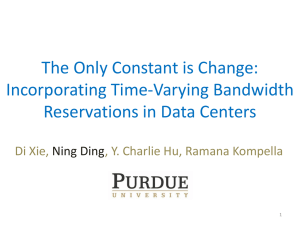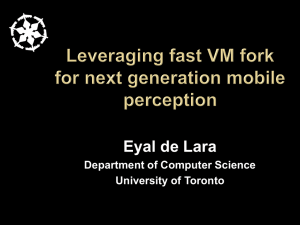23-AntonioPuliafito - Distributed Systems Group
advertisement
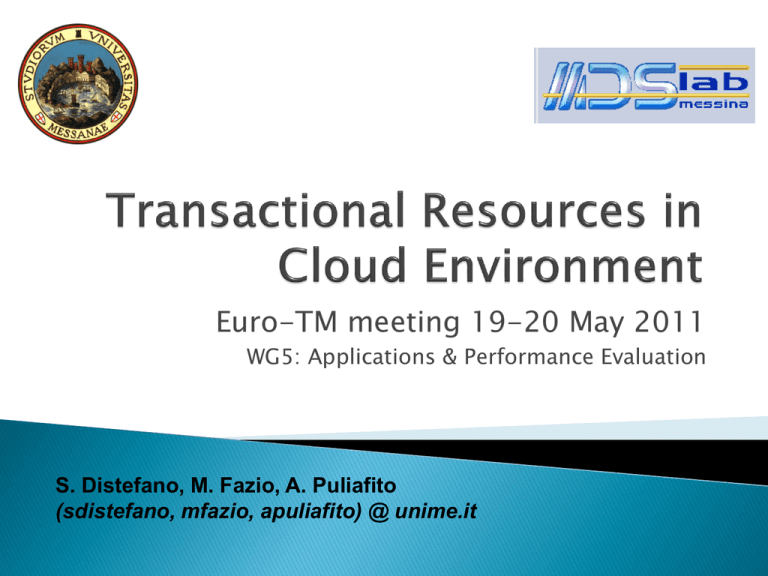
Euro-TM meeting 19-20 May 2011 WG5: Applications & Performance Evaluation S. Distefano, M. Fazio, A. Puliafito (sdistefano, mfazio, apuliafito) @ unime.it Applications/services and basic functions provided in a Cloud are based on the Virtual Resources which are abstracted from Physical Resources. Virtual physical resources, such as V-CPUs, V-Storages, V-Networks etc. V-Networks can be further divided into V-Routers, V-Switches, V-Firewalls, VPNs, V-Interfaces, V-Links based on physical Router/ Switch equipments. Computational resources are managed in terms of Virtual Machines(VMs) and/or Virtual Clusters (VCs). Virtual cluster: a group of VM instances providing same service, front-ended by a network load balancer 2 To prepare VMs with appropriate resources and make them ready for user applications ◦ Allocating resources to VMs to match the workloads To prepare a virtual cluster with appropriate instances and make it ready for virtual cluster computation To manage changes in resources availability through VMs restore or migration Goals: ◦ ◦ ◦ ◦ High resource utilization Energy efficiency reliability of services Low performance interference VM VM VM Virtualized Service VM Resource Broker 1 VM VM VM Virtualized Service Resource Broker 2 VM VM VM VM Virtualized Service Resource Broker 3 VM VM Virtualized Service Resource Providers (RPs) Business companies, cluster managers and even hosts which provide physical resources as IaaS (Infrastructure as a Service). Clients Users/Application that are interested in resource provisioning. They do not have knowledge regarding or control over the underlying data center infrastructures of the Clouds Resource Brokers (RBs) allocate resources for applications/services on multiple VMs in order to fulfill requests of different Clients manage resources provided by several RPs deploying VMs on several Physical Servers in the same Cloud, or even different Clouds. resource allocation in order to obtain the most cost-effective resources 5 collecting and indexing all the resources available from several cloud providers translating the application requirements (expressed in terms of high-level parameters such as execution time, throughput, transaction rate) into low-level criteria related to computing, storage and network distributed resources estimating the capacity needs of Virtual Machines (VMs), managing the available resources in order to ensure specific requirements of QoS monitoring the usage of allocated resources in order to guaratee the SLA with the user performing load balancing based on resource consumption. dynamically reallocating resources, so to have a more efficiently use of available resources when Application/Services request to allocate (extra) resources, checking whether they are authorized managing VMs migration among different physical sites. Transactions can be proposed as a lightweight mechanism to synchronize all the activities of resource Brokers Transactions alleviates many of the problems associated with the locking of VRs during the allocation task STM implementation to protect shared VRs 8 Managing concurrent allocations from different RBs ◦ cut off locks and their related problems in process concurrence Consistency of information whenever RPs update their resources RBs can force some kind of priorities among transactions Depending on the implementation, this priority could either be the age of a transaction or the type of activity (e.g. VM allocation, VM migration, resource discovery...) Granularity of transactions is object-based, where objects are VMs. Objects are shadowed, rather than changed “in place”. “Commit” tries to set the clone as the current object. “Abort” destroy the current clone and tries to set a new clone from the current objects. Buffering Local cache of available VR clones Conflict detection Cache coherence protocol Abort/Recovery Invalidate transactional cache activity Commit Validate transactional cache activity Abort/Recovery VM Resource Broker VM VM VM VM Conflict detection Commit Transaction Manager Buffering Resource Discovery VM VM VM VM VM Virtualized Service CM is an agent in the Transaction Manager. Notified of transaction events Decides what to do on a conflict: Several available policies In Cloud systems, new policies need to be designed to manage different types of activities ◦ Abort a transaction or spin-wait ◦ Which transaction to abort, if any ◦ Aggressive, Polite, Randomized, Greedy, Karma, Timestamp ◦ user-oriented policy ◦ provider-oriented policy ◦ economy-driven policy Representation of VRs ◦ VMs and VCs Atomization strategies ◦ to design RB tasks Managing dynamic resources ◦ resources abruptly disappear during a transaction Clever ◦ Virtual Infrastructure management layer to access and administrate private/hybrid clouds. ◦ Provider of Iaas ◦ https://clever.unime.it Cloud@Home ◦ volunteer computing into the Cloud computing paradigm ◦ C@H architecture works as a Cloud Broker ◦ https://cloudathome.unime.it/ RQM is responsible for the management of resources and services needed to achieve the application requirements imposed by the SLA manager. Cloud Providers SLA Discovery Layer Front end Request Handler Resource Manager Discovery Layer Interface Front end Interface State Tracker State Tracker ◦ It keeps the state of the requests stored by the Request Handler and their associated resources ◦ It also acts as the essential event dispatcher into which other components can hook routines. Deuce: runtime environment for Java Software Transactional Memory (STM) http://www.deucestm.org STM to support resource provisioning in Cloud environments: Managing concurrent RBs activities and resource updates from RPs Increasing VMs allocation efficiency Specific policies in the CM to design transaction management strategies Use case: C@H project
